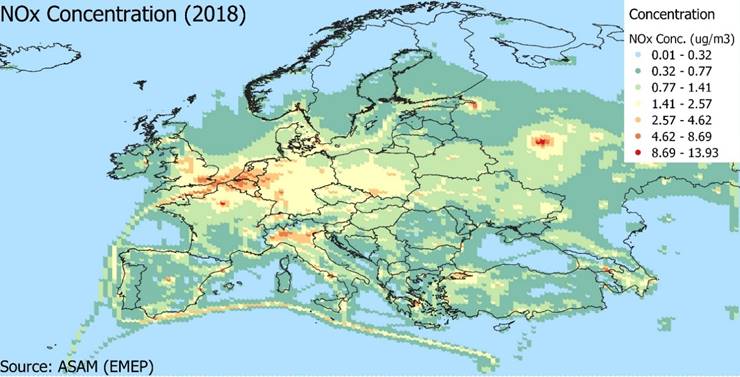The Abatement Strategies Assessment Model, ASAM, was originally developed in parallel with the IIASA RAINS model during development of the Second Sulphur Protocol and Gothenburg protocols under the UN ECE Convention on Long-Range Transboundary Air Pollution (now renamed as the Air Convention). These protocols were based on recognition that some areas of Europe were more sensitive to pollution than others, and that some countries contributed more pollution in these areas than others. This needed to be recognized in setting emission ceilings for each country, and a uniform reduction throughout Europe was not cost-effective.
In this context ASAM was used for a range of independent studies to complement the work of IIASA for the Task Force on Integrated Assessment Modelling - for example related to control of ammonia emissions from agriculture; and also to the control of particulate concentrations and impacts on human health which was not at that time included in the work of IIASA.
More recently, in support of revisions of the Gothenburg Protocol and development of the EU National Emissions Ceiling Directive, and also with the inclusion of Greenhouse Gases, the RAINS model evolved to become the GAINS (Greenhouse gas and Air pollution Interactions and Synergies) model. ASAM has mirrored these developments and operates using the most recent source-receptor relationships available as calculated by EMEP-MSW for use in the GAINS model, and updated when new data becomes available. Further details of work under the UN ECE may be found on https://unece.org/environmental-policy-1/air.
The ASAM model has been kept up to date with data from the Eulerian modelling of atmospheric transport of pollutants across Europe by EMEP-MSW, and used in source apportionment studies and scenario analysis for the impact of future European emissions on the UK. Integrated assessment at the national scale can then be nested within this larger scale assessment.

Relevant Publications
- ApSimon, H., Amann, M., Åström, S. & Oxley, T., 2009, Synergies in addressing air quality and climate change, Climate Policy, 9, pp 669-680, https://doi.org/10.3763/cpol.2009.0678
- Oxley T, ApSimon H, 2007, Space, time and nesting Integrated Assessment Models, Environmental Modelling & Software, 22, pp1732-1749, https://doi.org/10.1016/j.envsoft.2007.02.002
- ApSimon, H.M., Gonzalez del Campo, T. & Adams, H.S., 2001. Modelling long-range transport of primary particulate material over Europe. Atmospheric Environment, 35, 343-352, https://doi.org/10.1016/S1352-2310(00)00143-6
- Warren, R. & ApSimon, H., 2000, Integrated assessment of sulphur dioxide reduction schemes: Robustness studies, choice of environmental targets and country roles, Journal of Environmental Management, 59, 1, 3-20, https://doi.org/10.1006/jema.1999.0328
- Warren, R. & ApSimon, H., 1999, Uncertainties in integrated assessment modelling of abatement strategies: illustrations with the ASAM model, Environmental Science & Policy, 2, 6, 439-456, https://doi.org/10.1016/S1462-9011(99)00040-4
- ApSimon, H.M., Warren, R.F. & Wilson, J.J.N., 1994, The abatement strategies assessment model - ASAM: Applications to reductions of sulphur dioxide emissions across Europe, Atmospheric Environment, 28, 4, 649-663, https://doi.org/10.1016/1352-2310(94)90042-6.
For staff
If you are a new CEP staff member and would like to be included on the research webpages, or would like to amend your existing details, please submit this form (login required- only works for members of CEP).